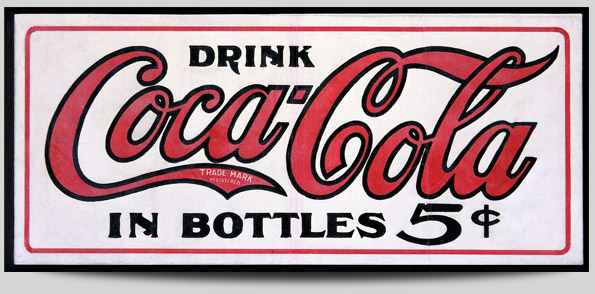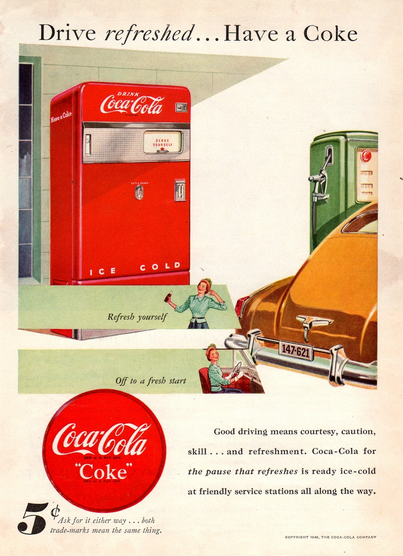Five Cents for a Half-Century

Coca-Cola was invented by an Atlanta pharmacist in 1886, with bottles of the bubbly elixir costing five cents. Nearly 150 years later, it’s still around, and arguably as popular as ever. It rarely comes in the glass bottles commonly found during its first 50 to 100 years, as glass has given way to plastic. A 20-ounce bottle will run you anywhere from $1.50 to $2.50, give or take, in the United States.
But as seen above, in an advertisement from circa 1905, a bottle of Coca-Cola (probably closer to eight ounces than 20, though) used to cost a nickel. And as seen below, in an advertisement from around 1948, it still cost a nickel nearly a half-century later. In fact, Coca-Cola bottles would cost a nickel until as late as 1959 — roughly seventy years after it debuted. Inflation alone should have caused the price to at least triple over that time, and the massively increased demand alone should have justified a significant price hike. What happened?

Blame the lawyers — and, maybe, President Eisenhower, too.
As reported by NPR, Coca-Cola was solely available at soda fountains early in its history. In 1899, a pair of Tennessee lawyers were interested in bottling the drink and approached Coca-Cola’s president in hopes of obtaining the rights to do so. For reasons unknown — NPR jokingly suggests that the Coke exec simply wanted to get the lawyers out of his office — the attorneys walked away with a lifetime deal to bottle Coke — at a very low, fixed price. For Coke, this turned out to be a big mistake, as bottled soda became a standby across the nation. If bottles of Coke sold for, say, 10 cents apiece, the two lawyers would make out like bandits, but the company wouldn’t make any additional money.
On the other hand, if prices stayed low, consumers may end up purchasing more than they typically would have otherwise. As Coca-Cola was getting paid a flat rate per unit of syrup, it therefore had incentive to increase the volume, not the price, of the drink. So it blanketed the country with ads saying things like “as always five cents;” “sold everywhere” with “5 cents” next to it; “in bottles, 5 cents,” etc. The ubiquity of the message made it impossible for retailers to raise their prices. So they didn’t.
In time, the bottlers and Coke itself renegotiated the syrup contract, and the price of Coke was set to rise. But then Coke realized it had a second problem — the vending machines which sold bottles of Coke could only be set to take a single nickel. And retrofitting them to accept a dime (which was probably easier than the mechanism needed to accept two nickels) would double the price of the soda overnight, something Coke was loath to do. NPR further reported that Coke asked the U.S Treasury and, ultimately, President Eisenhower himself, to create a 7.5 cent piece, specifically to get around this problem. The U.S. government did not oblige Coke’s wishes.
Of course, inflation can’t be avoided forever. In time, the cost of making a bottle of Coca-Cola approached and ultimately passed a nickel — by a dollar or two, so far.
Bonus fact: A can of Coke, in a tank of water, sinks. A can of Diet Coke, in the same tank of water, floats. (Here’s a brief, but old, video demonstration.) It takes a lot of sugar to make Coke as sweet as it is, but it takes a lot less aspartame (the artificial sweetener in Diet Coke) to accomplish a similar effect. But the extra sweetener in regular Coke makes the entire product denser than water, causing the can to sink.
From the Archives: From Abe to Zinc: Another thing that costs more than a nickel? A nickel.
Related: “For God, Country, and Coca-Cola: The Definitive History of the Great American Soft Drink and the Company That Makes It” by Mark Pendergrast. 4.6 stars on 26 reviews. Available on Kindle.
